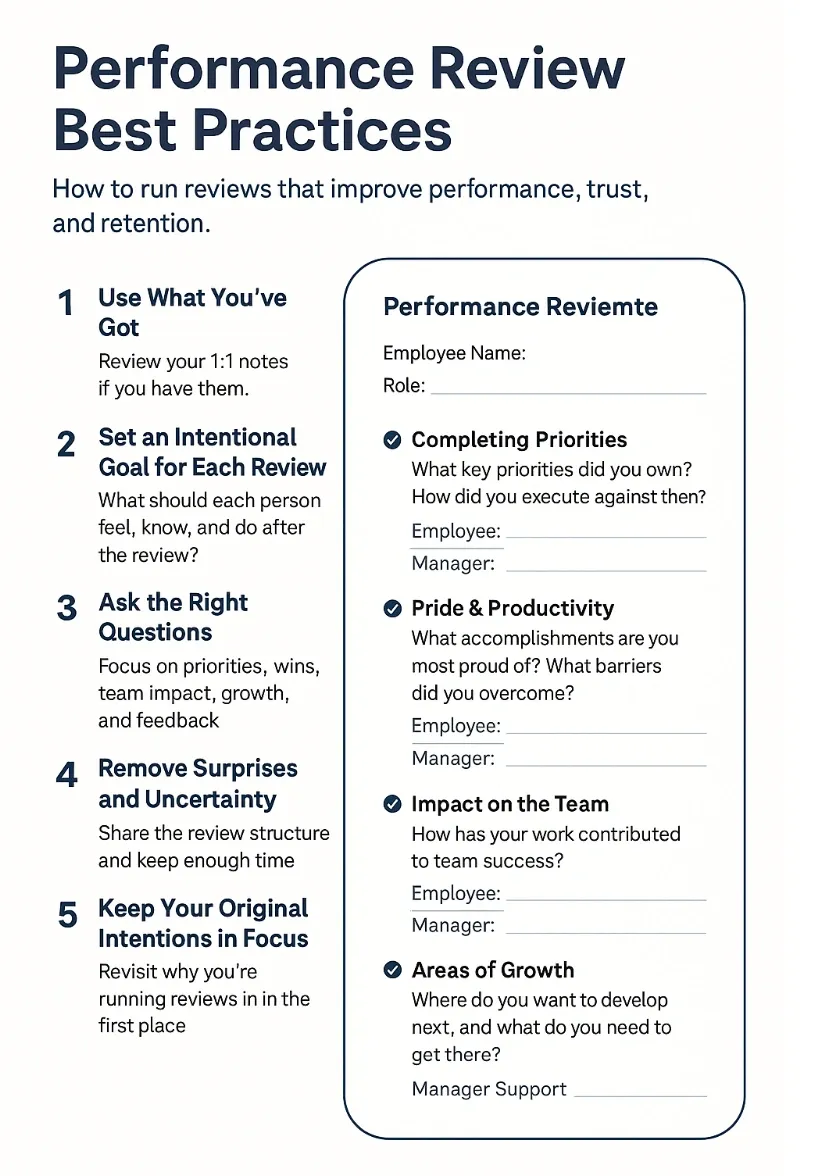It’s performance review season again. A time that can either fuel your team's momentum or breed anxiety and resentment. Whether you're guiding a lean startup or steering a rapidly expanding GTM organization, this leaders...


It’s performance review season again. A time that can either fuel your team's momentum or breed anxiety and resentment. Whether you're guiding a lean startup or steering a rapidly expanding GTM organization, this leadership ritual is far too critical to treat as an afterthought. A rushed or ill-prepared review can inflict more damage on morale and productivity than skipping one entirely.
Over the last 25 years, I’ve conducted well over 10,000 one-on-ones and performance reviews. And I can tell you unequivocally: once you lock in a system that prioritizes genuine feedback and growth, the impact on performance, retention, and trust is transformative.
The High Stakes of Performance Reviews:
Think of performance reviews as more than just evaluating the past; they are powerful opportunities to shape the future. When done right, they clarify expectations, reinforce alignment with company goals, and ignite a renewed sense of purpose. Conversely, poorly executed reviews can leave employees feeling undervalued, misunderstood, and ultimately, looking for opportunities elsewhere. This isn't just about checking boxes; it's about building a stronger, more engaged, and higher-performing team.
The 5 Performance Review Best Practices That Drive Results:
1. Use What You’ve Got (Especially Your 1:1 Notes):
If you’ve been running consistent 1:1s, congratulations – you're sitting on a goldmine of performance data. Your notes from those regular conversations provide specific examples, context, and a historical perspective that makes your review feedback far more impactful and less subjective. If 1:1s slipped this quarter, don’t panic, but recognize the missed opportunity. Start now and commit to doing better going forward. In the meantime, you can use the template at the end of this post to guide a thoughtful conversation.
📌 Pro tip: Your future reviews are only as strong as your 1:1 habit. Take notes. Build trust. You'll never have to “guess” where things stand.
2. Set an Intentional Goal for Each Review:
Remember, every team member is an individual with unique aspirations and development needs. Therefore, every review should feel tailored and purposeful. Before each meeting, ask yourself: “I want [Name] to leave this review feeling [X] (e.g., valued, motivated, clear), knowing [Y] (e.g., their key strengths, areas for focus, the company’s vision for their growth), and ready to [Z] (e.g., take specific actions, embrace new challenges, develop new skills).” This simple framework keeps you focused and ensures the conversation is meaningful – not just a mechanical recitation of past performance.
3. Ask the Right Questions (And Listen to the Answers):
The quality of your questions dictates the quality of the insights you’ll gain. Here are six key themes I use in almost every review, along with examples of what to ask and, more importantly, why each theme matters:
4. Remove Surprises and Uncertainty:
No one wants to feel ambushed or blindsided in a performance review. To foster a productive and trusting environment, share the review structure and any key discussion points ahead of time. Block out ample time for each review – these conversations often run longer than anticipated. And have a backup slot available if more in-depth discussion is needed. If emotions run high during the conversation, acknowledge them calmly and respectfully reset expectations: “I can see this is frustrating. Let’s take a breath, refocus, and finish this conversation productively. Sound good?”
📌 Remember: Calm, clear leadership during hard conversations builds long-term trust.
5. Keep Your Original Intentions in Focus:
Throughout the entire performance review process – from sending out templates and scheduling meetings to gathering input and delivering feedback – don’t lose sight of why you’re doing this. Performance reviews are not just an administrative task; they are a powerful tool for individual and team growth. Used well, they clarify expectations, reinforce alignment with strategic goals, and create momentum for future success.
To help you guide these important conversations, here is a simple structure you can use: Performance Review Template.
Performance Review Template:
Use this simple structure to guide the conversation and gather input from your team:
Employee Name: _______________________ | Role: _______________________
Final Thoughts:
Great performance reviews don’t just check boxes; they build alignment, raise standards, and deepen commitment. Be intentional in your preparation, ask insightful questions that encourage self-reflection, and never underestimate how much a well-run review can energize your team and propel your organization forward.
By Travis Janko, CEO of GSD Coach & Recruiting, helping SaaS founders build the top 5% of talent, FAST!
Get more expert advice for SaaS founders on sales hiring, recruiting strategies, team leadership, and building high-performing sales teams.


Get started today with a free, no-obligation discovery call. Just fill out the form and share your revenue goals. We’ll be in touch within 24 business hours to show you how our proven systems can accelerate your hiring process.
.avif)


Our proven methodology has helped SaaS companies across every growth stage build revenue teams that drive predictable, scalable results. Connect with us to discover how we can accelerate your hiring process and deliver the A-Player talent your company needs to reach its next milestone.